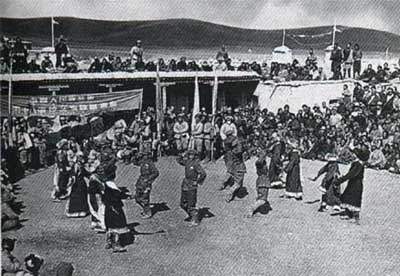|
Preface to negotiations on peaceful liberation of Tibet
In January 1951, the Tibetan government dispatched Kemo, Soinam Wmgdu (namely Soikmg Zhasa)Tubdain Dainda (namely Qoipi Tubdain) and the interpreter Puncog Zhaxi, brother-in-law of the 14th Dalal Lama, to India. They met with Yuan Zhongxian, the Chinese ambassador to India, and delivered letters to the Central Government, each from the 14th Dalai Lama, the Tibetan government and the national assembly respectively. The 14th Dalal Lama said in his letter: "I came to power in Tibet at the warm and sincere request of the Tibetan people... and on the eight day of the 10th Tibetan month.
A ceremony of authorization was held according to people's will. I am determined to do my best to realize the people's hopes in seeking peace... Now I ask Kanqoin and Renxi (referring to Kemo Soinam Wangdu and Tubdain Dainda-Ed.) for peace talks with the PLA, and have sent Ngapoi (Ngapoi Ngawang Jigmei) and others to Beijing for talks with the Central Government on matters concerning the settlement of the Tibetan issues." The letter asked whether more delegates had to be sent to Beijing via India.
The Central Government telegrammed Ambassador Yuan on January 29, 1951, asking him to tell the 14th Dalai and the Tibetan local government that the Central Government would welcome the Tibetan delegates sent to Beijing by the 14th Dalai Lama to take part in negotiations on the peaceful liberation of Tibet. The Central Government agreed to the delegation's travel by air via India, Hong Kong and Guangzhou. Ilence, a six-person delegation including Kemo Soinam Wangdu, Tubdain Dainda and interpreter Puncog Zhaxi arrived in Beijing on April 26, 1951.
In March 1951, Ngapoi Ngawang Jigmei suggested that he and Wang Qimei from the PLA agrrison in Qamdo go to Lhasa together for negotiations. The Central Government considered Beijing a better place to conduct the negotiations. Therefore, Ngapoi Ngawang Jigmei, Tubdain Lemoin, Samzhol Phodrangse (namely Sampoi Tenzin Toinzhub) left Qamdo on March27, 1951 and arrived in Beijing on April 20.
Both delegations from Tibet were well received by the Central Government. They conveyed letters from the 14th Dalai Lama to Chairman Mao Zedong, Premier Zhou Enlai, and Commanderin-Chief Zhu De. In the letter, the Dalai says, "the Tibetan government entrusted by the Tibetan assembly, asks the Central Government to place the Tibetan Province's legal position and to offer the opportunity for peace negotiations."
On April 27, a delegation of 25 people led by the Panchen Erdeni and leaders from Kampus Assembly arrived in Beijing.

The 18th army of PLA was performing for Tibetan people.
Signing of the agreement on methods for the Peaceful Liberation of Tibet
On May 23, the signing ceremony of The Agreement Between the Central Government and the Local Government of Tibet on Method for the Peaceful Liberation of Tibet (also known as The 17-Article Agreement) was held in Beijing.
Vice-Chairmen of the Central People's Government Zhu De and Li Jishen and Vice-Premier Chen Yun attended the ceremony. Chen Yun chaired the ceremony on behalf of Premier Zhou Enlai. Li Weihan and Ngapoi Ngawang Jigmei signed the agreement on behalf of the Central Government and the Tibetan government respectively.
Attendants at the signing ceremony also included relevant Party, government and army leaders and leaders of various democratic parties. Lhamin Yexei Curchen, Jijigmei and Nawang Jinba attended the signing ceremony on behalf of the 10th Panchen Erdeni.
Li Weihan and Ngapoi Ngawang Jigmei addressed the gathering, as did Vice-Chairman Zhu De.
|
